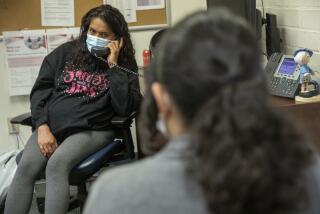Shortcut to Long Distance : Help Is on the Way in Figuring Out Crossed Lines, Busy Signals in Phone Companies’ Ads
- Share via
If you’re still trying to figure out what long-distance telephone company is right for you, welcome to the club.
Most consumers are thoroughly confused by the ongoing media blitz. And rightly so.
There are more than 400 long-distance telephone companies nationwide; about 150 operate in California. And in their zest to sign up customers, the three largest long-distance carriers--AT&T;, MCI and U.S. Sprint--are offering so many different plans that it seems impossible to choose.
The bad news is: There is no best or cheapest company overall.
You can still save money with any company by calling after 11 p.m. or on weekends. And all the telephone carriers have personalized and discount plans, so many that you practically have to be a mathematics professor to figure out which one--if any--might cut your phone bill.
According to a recent study, the difference between AT&T;, MCI and Sprint bills might be a matter of pennies. (See accompanying chart.)
The same study also found you might be better served by a different plan offered by your current company.
“There is a best and cheapest carrier for each individual or family, but not overall. It’s a personal thing and it depends on your calling pattern,” says Jacci Gruninger of the consumer group Telecommunications Research & Action Center (TRAC) in Washington, D.C.
A calling pattern is defined by the number of calls you make, where you call, how much time you spend on each and when most of the calls are made--days, evenings, nights, weekends.
The way to determine your pattern, says Gruninger, “is to sit down with three months’ worth of phone bills and look through them to calculate the average amount of time spent on the phone, the number of calls per month and where you’re calling. That takes an hour or two. Many times people make calls randomly when they can save money by putting themselves in a particular (calling) category. They could save 5% to 20% (on their bills).”
Gruninger advises consumers to check their phone bills once or twice a year to see if they are getting the best rates possible. But she admits that standard phone rates have not changed much in the past year. Discount plans--which, for example, may give you a flat rate for an hour’s worth of calls anywhere--can offer some savings, depending on your calling pattern.
“If you’re using the same long-distance service and plan as you were in November, 1990, and your calling patterns haven’t changed, the odds are that your phone bill is either just the same or slightly higher,” Gruninger says.
(Consumers can obtain a copy of TRAC’s “Tele-Tips Residential Long Distance Comparison Chart” by sending $2, to cover handling, and a self-addressed, stamped envelope to TRAC, P.O. Box 12038, Washington, D.C. 20005.)
According to Gruninger, the current discount plan that offers “significant savings” to some consumers is MCI’s “Friends and Family” plan. There are, of course, a few rules. In order to use that plan, all parties must be MCI subscribers. If you are an MCI subscriber and want to save money, you need to persuade a number of your family and friends to switch carriers and become part of your “Circle of Friends.”
Shop around and compare prices before you pick a company: call several of the major carriers, ask about their personalized rates and the discount rates and explain your calling habits.
“Since there are a zillion different (telephone) services and products, it is very confusing for consumers,” says Ken McEldowney, executive director of the San Francisco-based Consumer Action, a nonprofit consumer education and advocacy group. Sprint has nine different plans in California alone, he added.
Consumer Action has done a survey comparing long-distance companies’ rates in-state, out-of-state and internationally.
As part of its Telephone Information Project (TIP), the organization also publishes six fact sheets. The TIP project, funded by the Telecommunications Education Trust set up by the California Public Utilities Commission, mainly serves minority communities, the elderly and individuals with disabilities.
Any consumer or agency can obtain a free Consumer Action special newsletter on long-distance companies or any of the fact sheets by sending a self-addressed, stamped envelope to Consumer Action, 116 New Montgomery St., Suite 233, San Francisco, Calif. 94105.
The fact sheets include such topics as “How to Choose a Long Distance Phone Company,” “Save Money with Lifeline Service,” “Know Your Rights When Calling 900 Numbers,” “How to Dispute Your Phone Bill” and “Preventing Loss of Phone Service.” They are published in eight languages: English, Spanish, Chinese, Cambodian, Laotian, Vietnamese, Korean and Tagalog.
“Consumers can be completely overwhelmed trying to choose a phone service, particularly recent immigrants,” McEldowney says. “Some people who are new to the country don’t understand how to do this. Some of these people may never have seen a phone.”
A group of phone companies sponsors the nationwide Tele-Consumer Hotline to answer consumer questions about long-distance calls and other phone services. Hotline personnel, at (800) 332-1124, provide information in English and Spanish and also will send you pamphlets on choosing a long-distance company. Tele-Consumer Hotline operates from 9 a.m. to 5 p.m. Monday through Friday.
Cost is not the only factor if you’re thinking of switching long-distance companies. Sound quality is important. It won’t do you much good to get a cheaper phone rate if you can’t hear Uncle Joe in Detroit or your mother in France.
The major companies have access code numbers that enable you to use their system. To check on clarity of phone calls, you can place your call through the long-distance carrier’s five-digit access code. You don’t have to be a subscriber of the company to see how your call will go through on its lines.
Even after you pick a long-distance carrier, you can use other companies’ access codes. For example, if an earthquake has knocked out MCI’s service, you can call through AT&T; or Sprint, assuming their service is working, by using their access codes.
Dial the company’s access code, the area code and telephone number. Charges for the call will usually appear on your local telephone bill, although some companies bill separately.
AT&T;’s access code is 10288; MCI’s, 10222; Sprint’s, 10333.
Local phone companies will charge you a fee each time you switch your long-distance carrier. (Some long-distance companies will pick up that fee if you sign with them.) Pacific Bell, for example, charges $5.26 each time you change long-distance companies; GTE, $5.
Whether you are calling in-state, out-of-state or internationally, try to direct-dial your party. Each long-distance company has a surcharge for operator-assisted calls. Within California its $1.05 if you need operator help; $1.75, out-of-state; $3 or more, internationally.
COMPARISON OF Long-Distance Telephone Rates
DAY: Monday-Friday, 8 a.m. to 5 p.m.
EVENING: Sunday-Friday 5 p.m. to 11 p.m.
NIGHT/WEEKEND: Sunday-Friday, 11 p.m. to 8 a.m.; all day Saturday and Sunday until 5 p.m.
IN-STATE CALLS: Los Angeles to Fresno (10 minutes, 10 seconds)
AT&T; MCI SPRINT DAY $1.79 $1.77 $1.91 EVENING $1.35 $1.32 $1.47 NIGHT/WEEKEND $1.21 $1.20 $1.28
Rates do not include 3.4% Universal Lifeline surcharge added at the end of the bill on California intrastate calls.
OUT-OF-STATE CALLS: Los Angeles to Chicago (8 minutes)
AT&T; MCI SPRINT DAY $1.98 $1.92 $1.91 EVENING $1.19 $1.12 $1.11 NIGHT/WEEKEND $1.06 $1.02 $1.03
Source: Consumer Action


